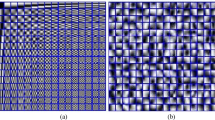Abstract
The transform base function method is one of the most commonly used techniques for seismic denoising, which achieves the purpose of removing noise by utilizing the sparseness and separateness of seismic data in the transform base function domain. However, the effect is not satisfactory because it needs to pre-select a set of fixed transform-base functions and process the corresponding transform. In order to find a new approach, we introduce learning-type overcomplete dictionaries, i.e., optimally sparse data representation is achieved through learning and training driven by seismic modeling data, instead of using a single set of fixed transform bases. In this paper, we combine dictionary learning with total variation (TV) minimization to suppress pseudo-Gibbs artifacts and describe the effects of non-uniform dictionary sub-block scale on removing noises. Taking the discrete cosine transform and random noise as an example, we made comparisons between a single transform base, non-learning-type, overcomplete dictionary and a learning-type overcomplete dictionary and also compare the results with uniform and nonuniform size dictionary atoms. The results show that, when seismic data is represented sparsely using the learning-type overcomplete dictionary, noise is also removed and visibility and signal to noise ratio is markedly increased. We also compare the results with uniform and nonuniform size dictionary atoms, which demonstrate that a nonuniform dictionary atom is more suitable for seismic denoising.
Similar content being viewed by others
References
Broadhead, M., 2008, The impact of random noise on seismic wavelet estimation: The Leading Edge, 27(2), 226–230.
Candes, E., and Donoho, D., 2002, New tight frames of curvelets and optimal representations of objects with smooth singularities: Technical Report, Stanford University.
Deng, C. Z., 2008, Research on image sparse representation theory and its applications: PhD Thesis, Huazhong University of Science and Technology.
Elad, M., and Aharon, M., 2006, Image denoising via sparse and redundant representations over learned dictionaries: IEEE Trans. Image Process, 15(12), 3736–3745.
Herrmann, F., and Hennenfent, G., 2008, Non-parametric seismic data recovery with curvelet frames: Geophys. J. Int., 173, 233–248.
Meyer, F. G., 1999, Fast compression of seismic data with local trigonometric bases, in Aldroubi, A., Laine, A., and Unser, M., Eds., Wavelet VII: Proc. SPIE 3813, 648–658.
Protter, M., and Elad, M., 2009, Image sequence denoising via sparse and redundant representations: IEEE Trans. Image Process, 18(1), 27–35.
Shan, H., Ma, J. W., and Yang, H. Z., 2009, Comparisons of wavelets, contourlets and curvelets in seismic denoising: Journal of Applied Geophysics, 69, 103–115.
Tang, G., and Ma, J. W., 2009, Application of total variation based curvelet shrinkage for three-dimensional seismic data denoising: IEEE Geosci. Remote Sensing Lett., 8(1), 103–107.
van den Berg, E., and Friedlander, M., 2008, Probing the Pareto frontier for basis pursuit solutions: SIAM J. Scientific Computing, 31(2), 890–912.
Wang, Y., and Wu, R., 2000, Seismic data compression by an adaptive local cosine/sine transform and its effects on migration: Geophysical Prospecting, 48, 1009–1031.
Xiao, Q., Deng, X. H., Wang, S. J., et al., 2009, Image denoising based on adaptive over-complete sparse representation: Chinese Journal of Scientific Instrument, 30(9), 1886–1890.
Zhang, C. M., Yin, Z. K., and Xiao, M. X., 2006, Overcomplete representation and sparse decomposition of signals based on redundant dictionary: Chinese Science Bulletin, 51(6), 628–632.
Zheludev, A. V. A., Koslo, B., Dan, D., and Ragoza, E. Y., 2004, On compression of segmented 3D seismic data: International Journal of Wavelets, Multiresolution and Information Processing, 2(3), 269–281.
Author information
Authors and Affiliations
Corresponding author
Additional information
This work was in part of financially supported by The National 973 program (No. 2007 CB209505), the Basic Research Project of PetroChina’s 12th Five Year Plan (No. 2011A-3601) and RIPED Youth Innovation Foundation (No. 2010-A-26-01).
Tang Gang received his PhD degree in mechanics from Tsinghua University in 2010. Now he is working in the Research Institute of Petroleum Exploration and Development, PetroChina. His research interests are rock physics and seismic reservoir prediction.
Rights and permissions
About this article
Cite this article
Tang, G., Ma, JW. & Yang, HZ. Seismic data denoising based on learning-type overcomplete dictionaries. Appl. Geophys. 9, 27–32 (2012). https://doi.org/10.1007/s11770-012-0310-z
Received:
Revised:
Published:
Issue Date:
DOI: https://doi.org/10.1007/s11770-012-0310-z




